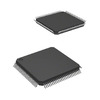Manufacturer Part Number
TM4C123AH6PMI7
Manufacturer
Texas Instruments
Introduction
The TM4C123AH6PMI7 is a 32-bit microcontroller from Texas Instruments' Tiva™ C series designed for embedded applications.
Product Features and Performance
ARM Cortex-M4F Core Processor
Operating speed of 80MHz
Extensive connectivity with CANbus, I2C, IrDA, Microwire, QEI, SPI, SSI, UART/USART
Integrated peripherals including DMA, PWM, BOD/Reset, POR, WDT
49 programmable I/O lines
256KB FLASH memory
2KB EEPROM storage
32KB RAM
12-bit Analog-to-Digital Converters (12 channels)
Internal Oscillator
Product Advantages
High-speed ARM Cortex-M4F core with floating-point support
Diverse connectivity for versatile applications
Comprehensive set of peripherals enhances functionality
Remarkable memory integration for robust programs
Precision ADCs for measurement applications
Key Technical Parameters
Core Size: 32-Bit Single-Core
Speed: 80MHz
Program Memory Size: 256KB
EEPROM Size: 2KB
RAM Size: 32KB
Voltage Supply (Vcc/Vdd): 1.08V to 3.63V
Number of I/O: 49
Data Converters: A/D 12x12b
Operating Temperature: -40°C to 85°C
Quality and Safety Features
Brown-out Detect/Reset for voltage monitoring
Power-On Reset (POR) for reliable operation
Watchdog Timer (WDT) to prevent system hangs
Compatibility
64-LQFP 10x10 packaging compatible with standard surface mount techniques
Wide range of I/O and interface support for compatibility with various peripherals
Application Areas
Industrial control systems
Automotive electronics
Home automation
Internet of Things (IoT) devices
Product Lifecycle
Active product status
Not near discontinuation
Ongoing support and availability of replacements and upgrades
Several Key Reasons to Choose This Product
Robust performance with a 32-bit ARM Cortex-M4F processor
High integration level with ample memory and peripherals
Flexible and diverse I/O options for complex projects
Reliable operation ensured by quality and safety features
Broad suitability across a range of applications from industrial to consumer electronics
Active lifecycle status ensures long-term project viability



 TM4C123BE6PMI7RTexas Instruments
TM4C123BE6PMI7RTexas Instruments TM4C123BE6PZIRTexas InstrumentsIC MCU 32BIT 128KB FLASH 100LQFP
TM4C123BE6PZIRTexas InstrumentsIC MCU 32BIT 128KB FLASH 100LQFP